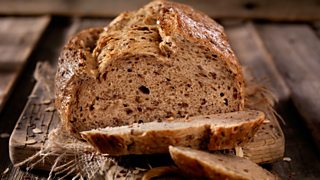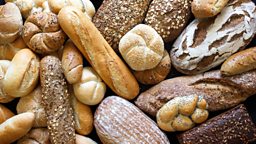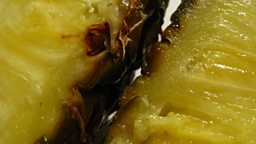10 things you knead to know about bread
In Slow Rise: A Bread-Making Adventure, Adrian Scarborough reads from journalist Robert Penn’s account of his search for the perfect bread made from ancient wheat grains.
For many people, baking has become a productive pastime during lockdown. To celebrate this, we've brought you ten tasty facts to digest about our trustiest, and crustiest, staple food.
1. The first baker could have lived around 100,000 years ago
Until very recently, we assumed that bread must have emerged with the first large scale grain agriculture around 10,000 years ago. But a Canadian anthropologist found a cave in Mozambique containing pounding stones, with the wild grain still embedded in them, which dated back to 100,000 years ago. Now that’s a bloomin’ old bloomer.
The Romans probably added things like grape juice, cumin, fennel and even bacon fat to flavour their dough.
2. Whole loaves of bread were preserved at Pompeii
Speaking on Radio 4's The Food Programme, "Modernist Bread" author Nathan Myhrvold delves into the history of the loaf. He describes how, in the case of Pompeii and Herculaneum, not only are there frescoes containing paintings of bread, but we have found "actual loaves of bread that were carbonised and preserved" centuries ago in the volcanic ashes of Mount Vesuvius. One of these loaves, from the 1st century AD, even has the maker’s stamp still visible.

3. The Ancient Romans had white bread
We know the Romans had white bread because Pliny the Elder – the general, statesman and scientist – wrote a book called Natural History, which documented methods of bread production. Nathan explains: "Pliny wrote about how they would sift the bread to get a whiter flour. But most Roman bread was made of pretty poor grain by today’s standards – not that high hydration, we think – and so it would have been a pretty dense loaf."
However, he admits that despite this a Roman loaf "probably was delicious" as they had salt, oils and all kinds of things to flavour their dough, including, according to Pliny, grape juice, cumin, fennel and even bacon fat.
4. There were bread riots in London in the 18th Century
The bread riots of 1795 and 1796 were prolonged outbreaks of disorder triggered by the scarcity and elevated price of food, especially bread, due largely to the economic strain of Britain’s war with revolutionary France. In October 1795, King George III’s coach was mobbed en route to the state opening of parliament with protesters apparently calling for "peace" and "bread".
5. There are paintings of Jesus eating pretzels
As part of his research into the history of bread, Nathan examined paintings through the ages that featured the food. He learnt that, dating from the 1500s, "there are German paintings of the Last Supper that show Christ and the apostles sitting down to a meal of pretzels."

Charlotte Smith visits a brewery making beer made from wasted bread on Farming Today.

6. French baguettes are not as traditional as we think they are
Most of us would probably presume that the baguette is the product of long-standing, traditional, rural baking traditions. However, the stick of bread is in fact a 20th-century urban bread, not a traditional bread of France at all. Nathan explains how its size is the giveaway: "A baguette in France is typically 250 grams. Now, in the 19th Century – whether it was the UK or France – bread was a major source of calories. In order to survive on nothing but bread, you need to eat half a kilogram to a kilogram per person, per day. You don’t come home with itty-bitty baguettes. In fact, the loaves of the 19th century were huge."
You don't actually have to knead to make a loaf of bread – kneading only speeds up the process.
7. The first ciabatta was baked in the 1980s
Just as baguettes are a modern invention, so too is the Italian ciabatta. The white, oblong bread was created in 1982 by a baker in Verona, Italy, in response to the popularity of the French stick. And how do we know this? Because the baker who invented it filed for a trade mark!
8. Mrs Beeton had a recipe for a "toast sandwich"
Food writer Isabella Beeton’s "Book of Household Management", published in 1861, contained the recipe for a toast sandwich. The clue really is in the name: place a cold piece of toast between two thin slices of bread and butter, and season with salt and pepper. NB: do not attempt to eat without a large glass of water to hand.
9. A squeeze of pineapple juice works wonders for dough
Braiding bread, like Jewish challah, can be tricky. It’s easy to get a mis-shapen finished product by stretching one of the strands more than the others. Interestingly, Nathan realised that the solution was sitting in his fruit bowl. Add a drop or two of pineapple juice to your dough – or any fruit with the enzyme that dissolves protein, like kiwi or papaya – and braiding your bread becomes a breeze.
10. There’s no need to knead
Kneading certainly speeds the bread-making process up but, according to Nathan’s research, that’s the only benefit. In fact, he says, "you can make great bread without kneading." Just "mix the bread by hand or with a spoon" until it’s at the "shaggy mass stage… not a finished dough at all", leave it out on the kitchen counter overnight – and bake. No more sore knuckles.

More from Radio 4
-
![]()
Slow Rise: A Bread-Making Adventure
Journalist Robert Penn’s account of his search for the perfect bread.
-
![]()
Baking in the Nordics
One of the world's great chefs, Magnus Nilsson, takes Dan Saladino on a Nordic baking tour.
-
![]()
Dan Saladino and Nathan Myhrvold discuss one of the biggest bread projects ever undertaken.
-
![]()
Sheila Dillon celebrates "real" bread and those who make it.




